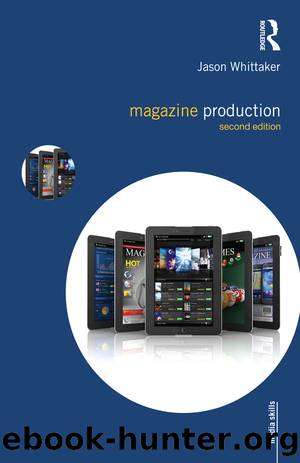Magazine Production by Jason Whittaker

Author:Jason Whittaker [Whittaker, Jason]
Language: eng
Format: epub
ISBN: 9781138122154
Barnesnoble:
Publisher: Taylor & Francis
Published: 2016-11-07T00:00:00+00:00
Structure and presentation
The presentation of a feature is extremely important for the vast majority of publications. Until the twentieth century, a magazine article looked very similar to a chapter in a book, possibly broken up by the occasional engraved image or divided into columns, but generally consisting of dense text. Innovations in photography and other areas of design, particularly typography, led to a much more experimental approach to presentation.
What should be remembered is the way that most of us read magazines: unlike a novel, where a reader starts at the beginning and works their way through in a linear fashion, most of us begin reading magazines by flicking through them from page to page.
When glancing through different features, the readerâs eye is caught by pictures, boxouts, captions and other visual information that can attract him or her to read the rest of the article. And this information is always visual: even text is a graphic object, so short blocks of text that stand out in some way may give an insight into the feature that makes us want to read on.
Typical visual devices employed within a feature are:
Boxes or boxouts, and panels: blocks of text that will be marked off from the main body of the article, for example by being coloured differently to the rest of the page. These can be extremely short â giving a contact address, for example â or short, almost mini-features in their own right that convey a substantial amount of information.
Bullet points: a simple way of drawing attention to a list of elements within an article.
Statistical tables: writing out numerical data is the easiest way to lose a reader and makes for very tedious features, whereas the inclusion of a graph or table can get across the point of that information at a glance.
Information graphics: increasingly popular, particularly in the B2B or more technically minded press, information graphics (such as a map of countries with data on population or diseases) is related to the charts and graphs mentioned above. It may also include such things as cutaways or technical drawings, where information is conveyed to the reader by a combination of image and captions.
Pull-quotes and captions: these are short extracts of text to illustrate an image or to make the page more visually appealing.
Download
This site does not store any files on its server. We only index and link to content provided by other sites. Please contact the content providers to delete copyright contents if any and email us, we'll remove relevant links or contents immediately.
Asking the Right Questions: A Guide to Critical Thinking by M. Neil Browne & Stuart M. Keeley(5711)
Autoboyography by Christina Lauren(5206)
Eat That Frog! by Brian Tracy(4484)
Dialogue by Robert McKee(4354)
Sticky Fingers by Joe Hagan(4148)
Journeys Out of the Body by Robert Monroe(3590)
Annapurna by Maurice Herzog(3449)
Full Circle by Michael Palin(3417)
Schaum's Quick Guide to Writing Great Short Stories by Margaret Lucke(3348)
Elements of Style 2017 by Richard De A'Morelli(3325)
The Art of Dramatic Writing: Its Basis in the Creative Interpretation of Human Motives by Egri Lajos(3039)
Atlas Obscura by Joshua Foer(2934)
Why I Write by George Orwell(2915)
The Diviners by Libba Bray(2910)
In Patagonia by Bruce Chatwin(2897)
The Fight by Norman Mailer(2889)
The Mental Game of Writing: How to Overcome Obstacles, Stay Creative and Productive, and Free Your Mind for Success by James Scott Bell(2876)
Venice by Jan Morris(2548)
The Elements of Style by William Strunk and E. B. White(2454)
